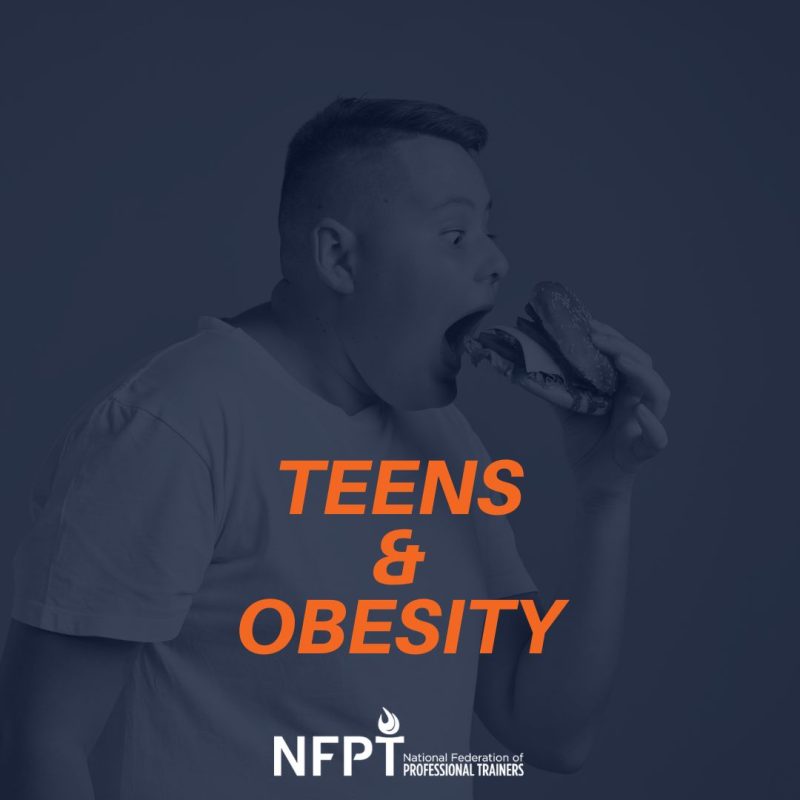
Obesity is a deeply concerning health issue in the entire world, for both adults and children–an issue certainly front and center for personal trainers. Adolescent obesity, along with weight-related diseases, has increased at a dramatic rate. According to the American College of Obstetricians and Gynecologists (ACOG), the increase in weight concerns in children aged 2-11 has slowed, while the prevalence of obesity in adolescents (12-19 years) continues to rise (ACOG).
The Teen Obesity Epidemic
According to the CDC, both children and adolescents are at risk for poor health. In children and adolescents between the ages of 2 and 19 in the years 2017-2020, the prevalence of obesity was 19.7% and affected nearly 15 million children and teens. Looking at just the adolescents (12-19 years), 22.2% were afflicted by obesity. Commonly, obesity prevalence is lower in higher-income groups and higher in lower-income groups (CDC).
While obesity and weight-related diseases among youth are a significant concern, we cannot overlook the additional economic burden attributed to this condition. A recent meta-analysis examining 48 eligible articles note that annual direct and indirect costs were projected to be $13.62 billion and $49.02 billion by 2050 – that’s slightly more than 25 years away (Ling, Chen, Zachary, & Ka0, 2023).
According to the American Academy of Child & Adolescent Psychiatry, approximately 12.7 million (17%) of children and adolescents are obese. Unhealthy weight gain due to poor diet and lack of exercise is responsible for over 300,000 deaths each year, and the annual cost to society for obesity is estimated at nearly $100 billion. The importance of confronting this issue can hardly be overstated as studies have shown that overweight children are more likely to become overweight adults unless they engage in lifestyle changes and develop healthier habits of eating and movement (AACAP).
Contributing Factors and Causes of Adolescent Obesity
A child or teen is considered obese when their weight is 10 percent higher than what is recommended for their height and body type. Various factors such as genetics, socioeconomic status, metabolic health and efficiency, poor sleep, and lifestyle choices contribute to the development of overweight and obesity – not just for teens, but for all individuals.
Some of the common causes of obesity in children and adolescents are general poor eating habits, lack of exercise, overeating or binging, family and peer problems, family history of obesity, certain medications (such as steroids), some psychiatric medications, low self-esteem, depression, emotional problems and stressful life events (such as divorce of parents, death of beloved one, or abuse).
There is a familial component as well. Children of obese parents are at higher risk to develop obesity. If both parents are overweight, there is an 80% chance of that child developing obesity. This can be a combination of genetics and lifestyle habits modeled for the children. Of note, there are certain medical conditions such as endocrine and neurological problems, which can also lead to obesity, but this more the exception than the rule.
Physical Activity and Teens
According to the CDC, less than 25% of children aged 6 to 17 years of age participate in 60 minutes of physical activity each day. Further, the WHO notes that more than 80% of the world’s adolescent population is insufficiently active. This means these individuals have a 20% to 30% increased risk of death compared to those who are sufficiently active. Roughly, this translates to only 1 in 5 teens meeting the recommended physical activity guidelines.
The current physical activity guidelines for this population include:
- Moderate-or-vigorous physical activity each day for an hour (or more).
- Most of the 60 minutes should be moderate-or-vigorous aerobic activity
- As part of 60 minutes a day, children and adolescents should include muscle-strengthening activities 3 days a week.
- As part of the 60 minutes a day, children and adolescents should include bone strengthening activities 3 days a week.
Statistically, both nationally and globally, we are falling far short of this minimum.
Fast Food and Teens
Examining statistics from the National Health and Nutrition Examination Survey from 2015-2018, we discover that over a third of children and adolescents consume fast food on a given day. We also know that this same demographic consumed on average 13.8% of their daily calories from fast food, and adolescents aged 12-19 consumed a higher percentage of calories from fast food than younger children. Interestingly, the percentage of calories consumed decreased between 2003 and 2010, and then increased between 2017 and 2018 (CDC).
Eating frequent fast food meals causes teens and young adults to gain more weight and face an increased risk of developing insulin resistance according to the results of a study funded by the National Heart, Lung, and Blood Institute (NHLBI).*
“Obesity and diabetes are on the rise in this country and this important study highlights the value of healthy eating habits,” said NHLBI Acting Director Barbara Alving, M.D.
After 15 years, those who ate at fast-food restaurants more than twice each week compared to less than once a week had gained an extra ten pounds and had a two-fold greater increase in insulin resistance, a risk factor for Type II diabetes, a major risk factor for heart disease. One reason for the weight gain may be that a single meal from one of these restaurants often contains enough calories to satisfy a person’s caloric requirement for an entire day.
“It’s extremely difficult to eat in a healthy way at a fast-food restaurant, although some restaurants have made strides in this area. Despite some of their recent healthful offerings, the menus still tend to include foods high in fat, sugar, and calories while being low in fiber and nutrients,” said lead author Mark Pereira, Ph.D., assistant professor of epidemiology at the University of Minnesota. People need to evaluate how often they eat meals at fast-food restaurants and think about cutting back, according to Pereira.
NHLBI’s Gina Wei, M.D. offers these tips when dining at a fast-food restaurant:
- Ask for the nutritional content. Know what you are eating.
- Choose salads and grilled foods over fried whenever possible.
- Keep portion sizes small.
- Get high-fat sauces and condiments, such as salad dressing and mayo, on the side and use in moderation.
- Choose a sugar-free drink like unsweetened ice tea or water.
There Is Progress, but More is Needed
It’s not all bad news. There is progress being made to influence children and teens toward a healthier lifestyle and diet. It’s now required that all nutrition facts panels list grams of trans fats, if any are present. Restaurant chains and fast food establishments also make their calorie content and nutritional information readily available on their websites and menus. Many food giants and manufacturers have elected to remove trans fat (and/or reduce the amount) from their products. And schools have taken active steps to improve hot lunches and cafeteria options.
However positive these changes are, we still have progress to make. First, children and teens are not often the decision-makers for food purchases in their household. If their parents or guardians are not aware of what constitutes a balanced diet, or face food shortages or insecurities, saving where they can will be a priority – and it makes sense. Further, although restaurant chains make their nutrition facts known on their websites and menus, if individuals making those purchases do not understand what those nutrition facts mean, it’s difficult for them to make an informed and balanced decision.
Obesity is a serious medical issue that affects not only adults but adolescents. Many children suffer from obesity because of inherited medical conditions, but also due to parental influences. Even with the pressures of television ads and fast-food restaurants, it is possible to teach children about healthy diets and the importance of daily physical activity. If parents take responsibility and maintain their own healthy lifestyles setting a positive example, they can instill healthy habits and ways of thinking in their children. A healthy lifestyle started at an early age can prevent serious medical conditions that stem from obesity.
What we really need to ask is if the epidemic is accurately described as “adolescent obesity”, or if the epidemic is one of poor nutrition and a lack of regular physical activity. As health and fitness coaches, personal trainers are well-positioned to influence the narrative by walking the walk, and guiding those around us into healthier lifestyles.







